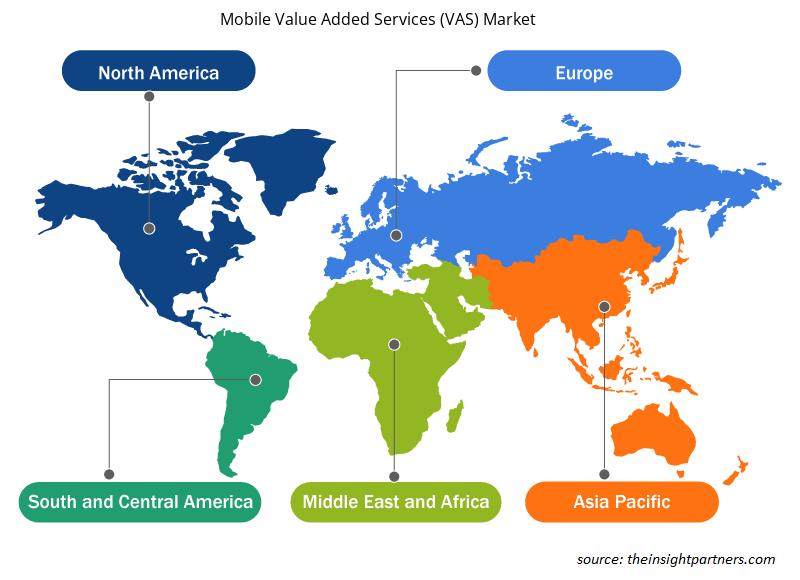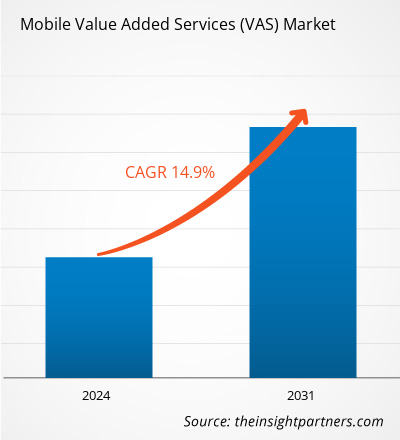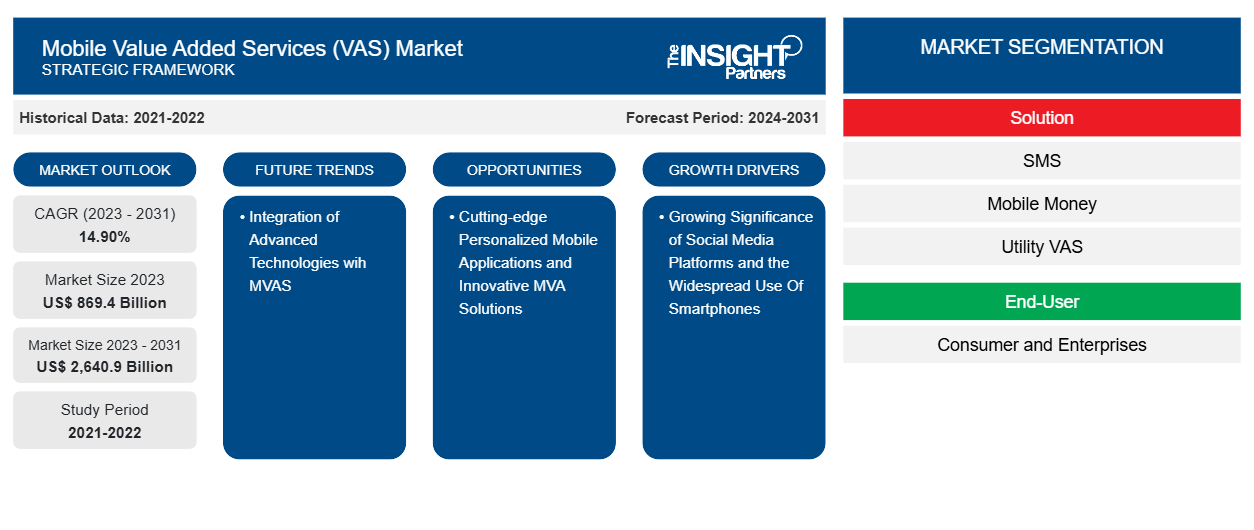Der Markt für mobile Mehrwertdienste (VAS) soll von 869,4 Milliarden US-Dollar im Jahr 2023 auf 2.640,9 Milliarden US-Dollar im Jahr 2031 anwachsen. Der Markt soll zwischen 2023 und 2031 eine durchschnittliche jährliche Wachstumsrate (CAGR) von 14,90 % verzeichnen. Die zunehmende Bedeutung von Social-Media-Plattformen und die weit verbreitete Nutzung von Smartphones dürften weiterhin die wichtigsten Trends auf dem Markt für mobile Mehrwertdienste (VAS) bleiben.VAS) market size is projected to reach US$ 2,640.9 billion by 2031 from US$ 869.4 billion in 2023. The market is expected to register a CAGR of 14.90% during 2023–2031. The growing implication of social media platforms and the widespread use of smartphones are likely to remain key mobile value added services (VAS) market trends.
Marktanalyse für mobile Mehrwertdienste (VAS)
Der einfache Zugang zu gemischten und aktualisierten Inhalten zu angemessenen Kosten steigert das Wachstum von OTT, einem Teil der mobilen Mehrwertdienste. Telekommunikationsunternehmen bieten VAS an, indem sie mit Online-Anzeigeplattformen der Unterhaltungsbranche wie Netflix zusammenarbeiten. Solche Kooperationen tragen zu VAS in Bezug auf Zahlungen, Bereitstellung von Inhalten, interaktives Marketing und Kundenbetreuung bei.
Marktübersicht für mobile Mehrwertdienste (VAS)
Mobile Mehrwertdienste (MVAS) umfassen Sprachkommunikationsdienste und andere Zusatzdienste, die von Mobilfunkanbietern bereitgestellt werden. Diese Dienste ermöglichen es Mobilfunkteilnehmern, Smartphones und Tablets für verschiedene nicht sprachbezogene Zwecke zu nutzen, darunter das Versenden von Kurznachrichten (SMS), Multimedia-Messaging-Diensten (MMS), mobilem E-Mail und Instant Messaging, mobilem Geld, standortbezogenen Diensten, mobiler Werbung und mobilem Infotainment. MVAS werden als Premiumfunktionen oder Ergänzungen zu grundlegenden Diensten vermarktet und werden verwendet, um die administrative und betriebliche Effizienz in einer breiten Palette von Diensten zu steigern. Sie bieten sowohl Dienstanbietern als auch Kunden Vorteile, indem sie die Endbenutzerfunktionalität erhöhen und verbesserte Analysen und Daten für die kommerzielle Nutzung bereitstellen.MVAS) include voice communication services and other additional services provided by mobile service providers. These services enable mobile subscribers to utilize smartphones and tablets for various non-voice purposes, including sending short message service (SMS), multimedia messaging service (MMS), mobile email & instant messaging, mobile money, location-based services, mobile advertising, and mobile infotainment. MVAS are marketed as premium features or supplements to essential services and are utilized to create administrative and operational efficiencies across a wide range of services. They offer benefits to both service providers and clients by increasing end user functionality and providing improved
Passen Sie diesen Bericht Ihren Anforderungen an
Sie erhalten kostenlos individuelle Anpassungen an jedem Bericht, einschließlich Teilen dieses Berichts oder einer Analyse auf Länderebene, eines Excel-Datenpakets sowie tolle Angebote und Rabatte für Start-ups und Universitäten.
-
Holen Sie sich die wichtigsten Markttrends aus diesem Bericht.Dieses KOSTENLOSE Beispiel umfasst eine Datenanalyse von Markttrends bis hin zu Schätzungen und Prognosen.
Markttreiber und Chancen für mobile Mehrwertdienste (VAS)
Wachsende Bedeutung von Social-Media-Plattformen und zunehmende Nutzung von Smartphones
Eine Vielzahl von Anbietern und ein massiver Wettbewerb zwischen Internetdienstanbietern implementieren in hohem Maße digitale Lösungen, fortschrittliche Anwendungen und zahlreiche Mehrwertdienste . Smartphones werden für den Zugriff auf verschiedene Internetanwendungen verwendet, z. B. zum Surfen auf Online-Websites, zum Teilen von E-Mails und zur Interaktion auf Social-Media-Plattformen. Telekommunikationsanbieter bieten eine breite Palette mobiler Mehrwertdienste an, darunter Sprach-, SMS- und Datendienste sowie andere zusätzliche Dienste, um das allgemeine Benutzererlebnis zu verbessern. Die zunehmende Verfügbarkeit preisgünstiger Smartphones ist ein Schlüsselfaktor für die zunehmende Akzeptanz des Geräts bei Bevölkerungsgruppen mit niedrigem Einkommen, was zur weltweiten Nachfrage nach mobilen Mehrwertdiensten beiträgt. Daher sind die wachsende Bedeutung von Social-Media-Plattformen und die weit verbreitete Nutzung von Smartphones Schlüsselfaktoren, die das Wachstum des Marktes für mobile Mehrwertdienste (VAS) vorantreiben.SMS, and data services, among other additional services, to improve the overall user experience. The growing availability of budget-friendly smartphones is a key factor boosting device adoption among the populations with low income, which contributes to the demand for mobile value added services worldwide. Thus, the growing significance of social media platforms and the widespread use of smartphones are key factors fueling the mobile value added service (VAS) market growth.
Hochmoderne personalisierte mobile Anwendungen und innovative MVA-LösungenMVA Solutions
Um den sich wandelnden Ansprüchen der Verbraucher gerecht zu werden, führen Telekommunikationsbetreiber und Serviceprovider weltweit eine breite Palette neuartiger und innovativer personalisierter mobiler Anwendungen und mobiler Mehrwertdienste (VAS) ein. Das dynamische Marktumfeld wird von Faktoren wie der wachsenden Zahl mobiler VAS-Abonnenten und Smartphone-Nutzer geprägt. Darüber hinaus trägt der Wunsch nach maßgeschneiderten Mehrwertdiensten sowohl von Unternehmen als auch von Verbrauchern zur Expansion des Marktes für mobile Mehrwertdienste (VAS) bei. Dieser Trend unterstreicht das Engagement der Branche, die sich wandelnden Bedürfnisse von Verbrauchern und Unternehmen durch hochmoderne mobile Lösungen und Dienste zu erfüllen.VAS) are being introduced by telecom operators and service providers worldwide to address evolving consumer demands. The dynamic market environment is shaped by factors such as the growing population of mobile VAS subscribers and smartphone users. Moreover, the desire for tailored value added services from both businesses and consumers contributes to the expansion of the mobile value added services (VAS) market. This trend highlights the industry's commitment to meeting the evolving needs of consumers and businesses through cutting-edge mobile solutions and services.
Segmentierungsanalyse des Marktberichts für mobile Mehrwertdienste (VAS)
Schlüsselsegmente, die zur Ableitung der Marktanalyse für mobile Mehrwertdienste (VAS) beigetragen haben, sind Lösung und Endbenutzer.
- Basierend auf der Lösung ist der Markt in SMS, mobiles Geld, Utility VAS, mobiles Infotainment, soziale Netzwerke, standortbasierte Dienste und andere segmentiert. Das SMS-Segment hielt im Jahr 2023 einen beträchtlichen Marktanteil.
- Nach Endverbraucher ist der Markt in Verbraucher und Unternehmen unterteilt. Das Verbrauchersegment hielt im Jahr 2023 einen erheblichen Marktanteil.
Mobile Value Added Services (VAS) Marktanteilsanalyse nach Geografie
Der geografische Umfang des Marktberichts zu mobilen Mehrwertdiensten (VAS) ist hauptsächlich in fünf Regionen unterteilt: Nordamerika, Asien-Pazifik, Europa, Naher Osten und Afrika sowie Süd- und Mittelamerika.
Im asiatisch-pazifischen Raum gibt es eine große Zahl von Mobiltelefonbenutzern. Diese Geräte werden hauptsächlich zu Unterhaltungszwecken verwendet, beispielsweise zum Ansehen von Nachrichten und Filmen, für mobiles Banking usw. Das Wachstum des Marktes für mobile Mehrwertdienste (VAS) im asiatisch-pazifischen Raum ist auf die steigende Zahl von Unternehmen und Branchen zurückzuführen, die verschiedene mobile Mehrwertdienste verwenden, sowie auf das florierende Vorhandensein von Einzelhandel, E-Commerce sowie IT- und Telekommunikationssektoren in der Region.
Regionale Einblicke in den Markt für mobile Mehrwertdienste (VAS)
Die regionalen Trends und Faktoren, die den Markt für mobile Mehrwertdienste (VAS) im Prognosezeitraum beeinflussen, wurden von den Analysten von Insight Partners ausführlich erläutert. In diesem Abschnitt werden auch die Marktsegmente und die Geografie für mobile Mehrwertdienste (VAS) in Nordamerika, Europa, im asiatisch-pazifischen Raum, im Nahen Osten und Afrika sowie in Süd- und Mittelamerika erörtert.

- Erhalten Sie regionale Daten zum Markt für mobile Mehrwertdienste (VAS)
Umfang des Marktberichts zu mobilen Mehrwertdiensten (VAS)
| Berichtsattribut | Details |
|---|---|
| Marktgröße im Jahr 2023 | 869,4 Milliarden US-Dollar |
| Marktgröße bis 2031 | 2.640,9 Milliarden US-Dollar |
| Globale CAGR (2023 - 2031) | 14,90 % |
| Historische Daten | 2021-2022 |
| Prognosezeitraum | 2024–2031 |
| Abgedeckte Segmente |
Nach Lösung
|
| Abgedeckte Regionen und Länder |
Nordamerika
|
| Marktführer und wichtige Unternehmensprofile |
|
Dichte der Marktteilnehmer für mobile Mehrwertdienste (VAS): Auswirkungen auf die Geschäftsdynamik verstehen
Der Markt für mobile Mehrwertdienste (VAS) wächst rasant. Die Nachfrage der Endnutzer steigt aufgrund von Faktoren wie sich entwickelnden Verbraucherpräferenzen, technologischen Fortschritten und einem größeren Bewusstsein für die Vorteile des Produkts. Mit der steigenden Nachfrage erweitern Unternehmen ihr Angebot, entwickeln Innovationen, um die Bedürfnisse der Verbraucher zu erfüllen, und nutzen neue Trends, was das Marktwachstum weiter ankurbelt.
Die Marktteilnehmerdichte bezieht sich auf die Verteilung der Firmen oder Unternehmen, die in einem bestimmten Markt oder einer bestimmten Branche tätig sind. Sie gibt an, wie viele Wettbewerber (Marktteilnehmer) in einem bestimmten Marktraum im Verhältnis zu seiner Größe oder seinem gesamten Marktwert präsent sind.
Die wichtigsten Unternehmen auf dem Markt für mobile Mehrwertdienste (VAS) sind:
- EITC
- Airtel (Robi Axiata Limited)
- Mobilität
- MTN KAMERUN
- Numeko Bili?im Teknoloji Sanayi Ticaret A.?.
- Oman Telekommunikationsunternehmen
Haftungsausschluss : Die oben aufgeführten Unternehmen sind nicht in einer bestimmten Reihenfolge aufgeführt.

- Überblick über die wichtigsten Akteure auf dem Markt für mobile Mehrwertdienste (VAS)
Neuigkeiten und aktuelle Entwicklungen zum Markt für mobile Mehrwertdienste (VAS)
Der Markt für mobile Mehrwertdienste (VAS) wird durch die Erhebung qualitativer und quantitativer Daten nach Primär- und Sekundärforschung bewertet, die wichtige Unternehmensveröffentlichungen, Verbandsdaten und Datenbanken umfasst. Nachfolgend sind einige der Entwicklungen auf dem Markt für mobile Mehrwertdienste (VAS) aufgeführt:
- Monty Mobile, das schnell wachsende globale Telekommunikationsunternehmen, das innovative Technologie- und Kommunikationslösungen anbietet, kündigte die Integration von KI und maschinellem Lernen in seine Mehrwertdienste (VAS) an. Diese Integration, OmniVAS genannt, wird es den Mobilfunkbetreibern ermöglichen, ihre Umsätze in kürzester Zeit zweistellig zu steigern. Durch den Einsatz von Data Mining analysiert diese hochmoderne KI-Lösung automatisch das Verbraucherverhalten und optimiert Upselling und Cross-Selling, was sich direkt auf die Steigerung der Kundenzufriedenheit und damit auf die Steigerung der Umsätze der Betreiber auswirkt, indem sie ihren Umsatz steigern, ihr Verständnis des Kundenverhaltens durch maschinelles Lernen und aufschlussreiche Erkenntnisse verbessern und es ihnen ermöglichen, intelligente Entscheidungen und Vorhersagen zu treffen. (Quelle: Monty Mobile, Pressemitteilung, 2023)
- Clickatell, der führende Anbieter von Chat Commerce und Business Messaging, hat seine Chat 2 Pay-Funktion für Südafrikas größtes integriertes Kommunikationsunternehmen, Telkom, eingeführt. Millionen von Telkom-Kunden können jetzt Zahlungen über WhatsApp tätigen, den größten Chat-Kanal des Landes. (Quelle: Clickatell, Unternehmenswebsite, 2023)
Marktbericht zu mobilen Mehrwertdiensten (VAS): Abdeckung und Ergebnisse
Der Bericht „Marktgröße und Prognose für mobile Mehrwertdienste (VAS) (2021–2031)“ bietet eine detaillierte Analyse des Marktes, die die folgenden Bereiche abdeckt:
- Marktgröße und Prognose für mobile Mehrwertdienste (VAS) auf globaler, regionaler und Länderebene für alle wichtigen Marktsegmente, die im Rahmen des Berichts abgedeckt sind
- Markttrends für mobile Mehrwertdienste (VAS) sowie Marktdynamiken wie Treiber, Einschränkungen und wichtige Chancen
- Detaillierte PEST/Porters Five Forces- und SWOT-Analyse
- Marktanalyse für mobile Mehrwertdienste (VAS), die wichtige Markttrends, globale und regionale Rahmenbedingungen, wichtige Akteure, Vorschriften und aktuelle Marktentwicklungen umfasst
- Branchenlandschaft und Wettbewerbsanalyse, einschließlich Marktkonzentration, Heatmap-Analyse, prominenten Akteuren und aktuellen Entwicklungen für den Markt für mobile Mehrwertdienste (VAS).
- Detaillierte Firmenprofile
- Historische Analyse (2 Jahre), Basisjahr, Prognose (7 Jahre) mit CAGR
- PEST- und SWOT-Analyse
- Marktgröße Wert/Volumen – Global, Regional, Land
- Branchen- und Wettbewerbslandschaft
- Excel-Datensatz
Aktuelle Berichte
Erfahrungsberichte
Grund zum Kauf
- Fundierte Entscheidungsfindung
- Marktdynamik verstehen
- Wettbewerbsanalyse
- Kundeneinblicke
- Marktprognosen
- Risikominimierung
- Strategische Planung
- Investitionsbegründung
- Identifizierung neuer Märkte
- Verbesserung von Marketingstrategien
- Steigerung der Betriebseffizienz
- Anpassung an regulatorische Trends























 Kostenlose Probe anfordern für - Markt für mobile Mehrwertdienste (VAS)
Kostenlose Probe anfordern für - Markt für mobile Mehrwertdienste (VAS)